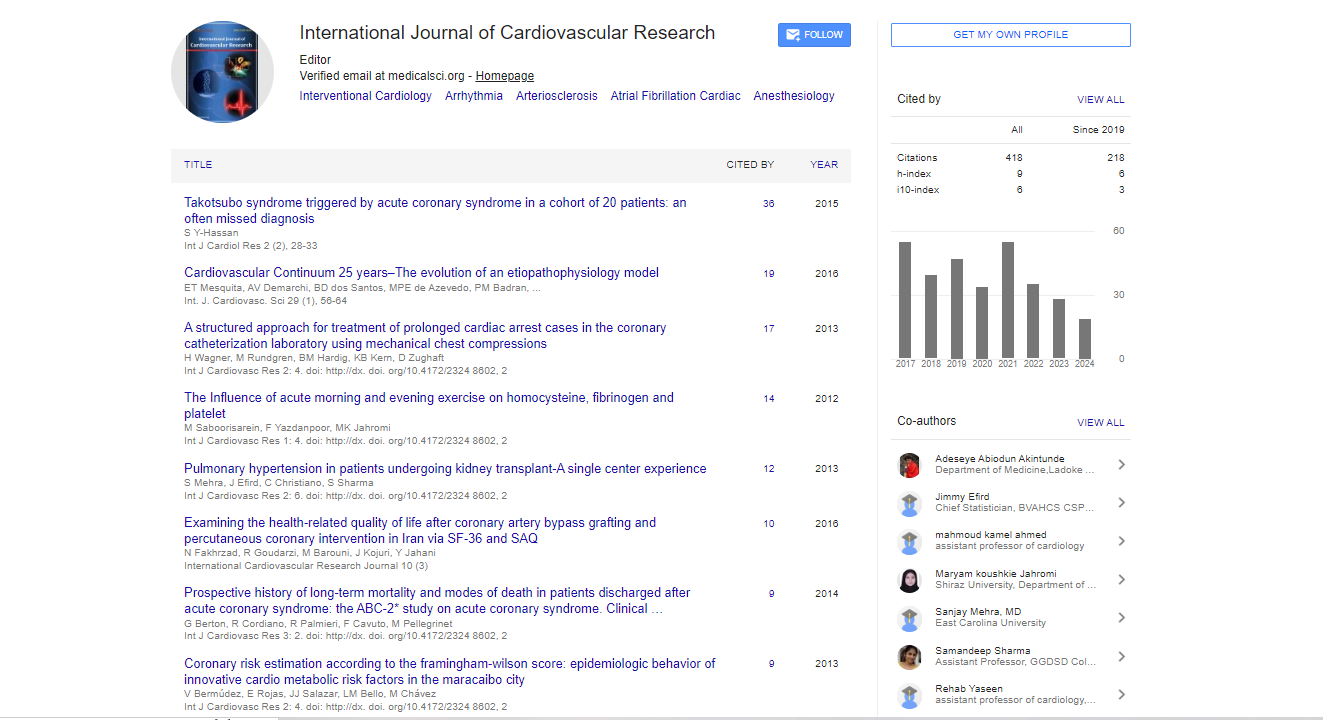Perspective, Int J Cardiol Res Vol: 13 Issue: 3
Recent Advancements and Impact of Cineangiography on Vascular Disease Management
Brent Oseli*
1Department of Medicine, New York University School of Medicine, New York, United States of America
*Corresponding Author: Brent Oseli,
Department of Medicine, New York
University School of Medicine, New York, United States of America
E-mail: oseli.b@nyumc.org
Received date: 27 May, 2024 Manuscript No. ICRJ-24-144350;
Editor assigned date: 30 May, 2024, PreQC No. ICRJ-24-144350 (PQ);
Reviewed date: 13 June, 2024, QC No. ICRJ-24-144350;
Revised date: 21 June, 2024, Manuscript No. ICRJ-24-144350 (R);
Published date: 28 June, 2024, DOI: 10.4172/2324-8602.1000566
Citation: Oseli B (2024) Recent Advancements and Impact of Cineangiography on Vascular Disease Management. Int J Cardiol Res 13:3.
Description
Cineangiography, an advanced imaging technique, plays an important role in modern diagnostic medicine. By utilizing continuous X-ray imaging and high speed film or digital recording, it provides, real time visualization of the vascular system. This method offers invaluable insights into the physiology and pathology of blood vessels, aiding in the diagnosis and management of a range of cardiovascular conditions. Cineangiography, also known as cine coronary angiography or cineangiogram, operates on the principles of X-ray imaging. Unlike regular angiography, which captures static images, cineangiography involves a continuous series of rapid X-ray images, creating a motion picture of the blood flow through the vascular system. This is achieved by injecting a radiopaque contrast agent into the blood vessels, enhancing their visibility against the surrounding tissues on the X-ray film or digital detector. The process begins with the administration of a contrast medium, usually iodinebased, which temporarily renders the blood vessels opaque to X-rays. The imaging system then captures successive frames at high speed, typically 10 to 30 frames per second, resulting in a dynamic sequence that reveals the flow of blood through the arteries and veins. This temporal resolution allows for the observation of physiological processes such as blood flow dynamics, vessel wall motion and the effects of various pathological conditions.
Applications in clinical practice
Cineangiography is primarily used in the evaluation of coronary arteries, but its applications extend to various vascular systems. In cardiology, it is instrumental in diagnosing Coronary Artery Disease (CAD) by visualizing the presence and severity of arterial blockages. The technique is employed during coronary angioplasty and stenting procedures to guide catheter placement and assess the results of intervention. In addition to cardiology, cineangiography has applications in neurovascular imaging. It helps in diagnosing and managing conditions such as aneurysms, arteriovenous malformations and stenoses in the cerebral vessels. In peripheral vascular imaging, cineangiography is used to assess blood flow in the limbs, detect Peripheral Artery Disease (PAD) and guide surgical or endovascular treatments. Furthermore, cineangiography is invaluable in evaluating congenital vascular anomalies, such as vascular malformations and abnormal connections between arteries and veins. By providing a detailed view of the vascular architecture, it aids in surgical planning and the assessment of therapeutic outcomes.
Advantages of cineangiography
One of the primary advantages of cineangiography is its ability to provide real time, dynamic imaging of the vascular system. This temporal resolution is important for accurately assessing blood flow and identifying abnormalities that are not visible in static images. The technique offers high spatial resolution, enabling detailed visualization of vessel walls, stenoses and other structural features. Another significant advantage is the technique's utility in guiding interventional procedures. During catheter-based interventions, such as angioplasty and stenting, cineangiography allows for continuous monitoring of the procedure, ensuring precise catheter placement and immediate assessment of therapeutic efficacy. Moreover, cineangiography's ability to evaluate both the anatomical and functional aspects of the vascular system makes it a important tool in clinical practice. It facilitates comprehensive assessments of blood flow, vessel patency and the effects of therapeutic interventions, contributing to improved patient outcomes.
Despite its advantages, cineangiography has certain limitations and challenges. The primary concern is related to radiation exposure. Continuous X-ray imaging involves higher doses of radiation compared to conventional angiography, which may pose risks to patients and medical personnel. Efforts to minimize radiation exposure, such as using advanced imaging technology and optimizing imaging protocols, are essential to mitigate this risk. Another limitation is the dependence on contrast agents, which, while enhancing image quality, can pose risks to patients with allergies or renal impairment. The administration of contrast medium requires careful consideration of patient history and potential contraindications. Additionally, cineangiography may not always provide sufficient detail in cases of small or complex vascular structures. In such instances, complementary imaging modalities, such as Magnetic Resonance Angiography (MRA) or Computed Tomography Angiography (CTA), may be required to obtain a more comprehensive assessment.
Recent advancements in cineangiography include the development of Digital Subtraction Angiography (DSA) and the integration of three-dimensional imaging techniques. DSA enhances image quality by subtracting the background and highlighting the contrast filled vessels, resulting in clearer visualization of vascular structures. The incorporation of 3D imaging provides a more detailed and spatially accurate representation of the vascular system, aiding in the diagnosis and planning of complex interventions. Future directions in cineangiography study focus on reducing radiation exposure, improving image resolution and enhancing the integration of imaging data with other diagnostic tools. Innovations in contrast agents, imaging technology and computational techniques provide advancing the field and further expanding the applications of cineangiography in clinical practice.
Conclusion
Cineangiography stands as a basis in vascular imaging, offering dynamic, real-time visualization of the blood vessels and their functions. Its applications include cardiology, neurovascular imaging and peripheral vascular assessments, providing important insights into both anatomical and functional aspects of the vascular system. Despite challenges related to radiation exposure and contrast medium use, ongoing advancements continue to enhance the technique's efficacy and safety. Cineangiography remains a essential tool in the diagnosis and management of vascular conditions, contributing to improved patient care and outcomes.
 Spanish
Spanish  Chinese
Chinese  Russian
Russian  German
German  French
French  Japanese
Japanese  Portuguese
Portuguese  Hindi
Hindi 



